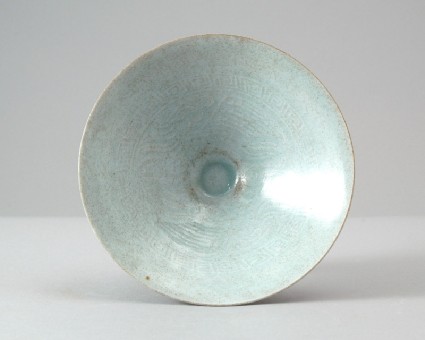The Barlow Collection
A select catalogue of the Barlow collection of Chinese Ceramics, Bronzes and Jades by the University of Sussex (published Sussex, 2006).

Publications online: 456 objects
White ware bowl with phoenixes
- loan
-
Literature notes
This shape and design appear to have been popular with several Jiangxi kilns. Similar bowls have, for example, been excavated from the Yonghe kilns in the Ji’an area of Jiangxi (see Zhao Bing, ‘Les imitations de porcelaines de Ding du Xe au XIVe siècle: le cas des officines de potiers de Jizhou au Jiangxi’, Arts Asiatiques, vol.56, 2001, fig.17).
The conical bowl rests on a very narrow, nearly solid foot with very shallow footring. It is evenly potted, the inside moulded with two phoenixes with spread wing and long tail feathers, curling around the small plain base inside, surrounded by a slanting key-fret border. The blue-tinged glaze leaves the base exposed in the buff-coloured biscuit and shows overall black speckling. -
Details
- Associated place
-
Asia › China › Jiangxi province (place of creation)
- Date
-
13th century (1201 - 1300)
Southern Song Dynasty (AD 960 - 1127)
Yuan Dynasty (1279 - 1368)
- Material and technique
- porcelain, thrown, with press-moulded decoration under a bluish-white glaze (qingbai ware); unglazed base; glazed rim
- Dimensions
-
5.9 cm (height)
17.1 cm (diameter)
- Material index
- Technique index
-
formed › moulded › press moulded,
- Object type index
- No. of items
- 1
- Credit line
- Lent by the Sir Alan Barlow Collection Trust.
- Accession no.
- LI1301.50
-
Further reading
University of Sussex, and Arts and Humanities Research Council, The Barlow Collection, supervised by Regina Krahl, Maurice Howard, and Aiden Leeves (Sussex: University of Sussex, 2006), no. C14
Glossary (2)
glaze, porcelain
-
glaze
Vitreous coating applied to the surface of a ceramic to make it impermeable or for decorative effect.
-
porcelain
Ceramic material composed of kaolin, quartz, and feldspar which is fired to a temperature of c.1350-1400⁰c. The resulting ceramic is vitreous, translucent, and white in colour.
Location
-
- currently in research collection
Objects are sometimes moved to a different location. Our object location data is usually updated on a monthly basis. Contact the Jameel Study Centre if you are planning to visit the museum to see a particular object on display, or would like to arrange an appointment to see an object in our reserve collections.
Publications online
-

The Barlow Collection
This shape and design appear to have been popular with several Jiangxi kilns. Similar bowls have, for example, been excavated from the Yonghe kilns in the Ji’an area of Jiangxi (see Zhao Bing, ‘Les imitations de porcelaines de Ding du Xe au XIVe siècle: le cas des officines de potiers de Jizhou au Jiangxi’, Arts Asiatiques, vol.56, 2001, fig.17).
The conical bowl rests on a very narrow, nearly solid foot with very shallow footring. It is evenly potted, the inside moulded with two phoenixes with spread wing and long tail feathers, curling around the small plain base inside, surrounded by a slanting key-fret border. The blue-tinged glaze leaves the base exposed in the buff-coloured biscuit and shows overall black speckling.
Notice
Object information may not accurately reflect the actual contents of the original publication, since our online objects contain current information held in our collections database. Click on 'buy this publication' to purchase printed versions of our online publications, where available, or contact the Jameel Study Centre to arrange access to books on our collections that are now out of print.
© 2013 University of Oxford - Ashmolean Museum



